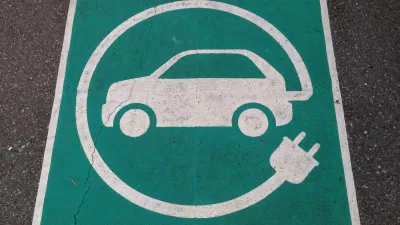There's nothing like the convenience of charging one's electric vehicle at home, assuming you have a garage, driveway, or your apartment building has a charger. California cities and utilities are working to increase EV infrastructure on all fronts.
The good news for for electric vehicle (EV) owners or prospective owners/lessees, even those who live in multifamily housing, is that more charging infrastructure is coming to California thanks to utilities and a hefty state settlement with Volkswagen, reports Kate Galbraith for the San Francisco Chronicle on Nov. 24.
-
A year ago, regulators approved plans from Pacific Gas and Electric Co. to spend $130 million to install 7,500 charging stations in Northern and Central California. It’s an enormous number, and at least 20 percent — but perhaps as much as half — will be used for stations serving multifamily housing.
- PG&E also has proposed spending $22 million for fast charging stations near multifamily buildings; this would help show whether such chargers could increase electric car usage among residents who lack garages, said Max Baumhefner, an attorney with the Natural Resources Defense Council..
For Southern California residents, Southern California Edison will spend $22 million to offset the cost of installing 1,500 public charging stations at workplaces and multi-unit apartment and condominium complexes within its 50,000-square-mile service area.
- California is getting about $800 million for charging infrastructure through the settlement with Volkswagen over the German automaker’s diesel emissions cheating devices. Another VW settlement could add millions more.
The first $200 million installment was approved by the California Air Resources Board in late July. Three remaining $200 million payments will be paid within 10 years.
=================================================================================================================================
But there's one group of prospective EV owners that remains difficult to serve – those who don't live in buildings with garages or off-street parking. According to a 2013 Carnegie Mellon transportation research paper [pdf], "[j]ust 56 percent of vehicles in the U.S. have a dedicated parking spot off the street," notes Galbrainth.
While more EV chargers at work sites, supermarkets, and public facilities like train stations, libraries, and public parking lots will clearly help all EV drivers, motorists who lack home chargers may likely opt for vehicles with polluting internal combustion engines for the ease of refueling, at least until charging times become competitive with the minutes it takes for a conventional "fill-up." Sadly, a pilot project from Berkeley illustrates the high cost of meeting these residents' home charging needs.
"The city is completing a pilot project that allows a small number of property owners without garages to install a residential charging station, something not previously permitted," adds Galbraith. "But it’s expensive — participants adding curbside stations probably spend $5,000 to $10,000 [..] and only a handful of people have done it. [See Chronicle photo of curbside charger in action in Berkeley].
Even after spending the money, "which include electrician's fee and sidewalk work", the resident has no claim on the parking spot, i.e., no guarantee that he/she can use the charger.
Los Angeles is pursuing the curbside goal from a different angle by mounting chargers on utility poles as part of a pilot program that began a year ago.
The "Los Angeles Department of Water and Power installed a utility pole-mounted electric vehicle (EV) charger in Watts," according to LADWP. "The curbside charger [...] is likely the first such power pole public charger in the country according to utility officials."
State legislation
Three new laws, among a dozen bills to spur sales of zero emission vehicles in California signed into law by Gov. Jerry Brown this year, will also provide more public EV charging infrastructure in the Golden State, including the challenging curbside locations. Joseph Bebon reports for NGT News:
- A.B. 1082 and A.B. 1083 from Assemblymember Autumn R. Burke (D-Inglewood): Authorize pilot programs to allow for new electric vehicle charging stations at state parks and beaches [and school facilities and other educational institutions]. A signing message for those bills can be found here [pdf].
- A.B.1452 by Assemblymember Al Muratsuchi, D-Torrance: Authorizes local jurisdictions to dedicate on-street parking spaces on public streets for the exclusive purpose of charging a parked electric vehicle, provided appropriate signage is installed. The bill was sponsored by Los Angeles Mayor Eric Garcetti.
A 2014 law authored by Muratsuchi provides the basis for providing chargers in multifamily buildings, per a July post:
Tenants do have the right by law to have the property owner install chargers at their home or business (some exceptions apply) if they are willing to foot the bill. AB 2565 by Assemblymember Al Muratsuchi (D-Torrance) was one of six bills that Gov. Brown signed in September 2014 to strengthen the EV market, and that was after he signed six bills in 2013 to boost EV sales.
Comparing EV infrastructure among cities
“Among leading EV markets around the world, denser cities like Amsterdam have one public charger per about five electric cars, compared to one public charger per 25-30 electric cars in California markets,” Nic Lutsey, who leads electric vehicle research for the International Council on Clean Transportation, said in an email to Galbraith.
FULL STORY: For drivers without garages, charging a big barrier to electric cars

Maui's Vacation Rental Debate Turns Ugly
Verbal attacks, misinformation campaigns and fistfights plague a high-stakes debate to convert thousands of vacation rentals into long-term housing.

Planetizen Federal Action Tracker
A weekly monitor of how Trump’s orders and actions are impacting planners and planning in America.

In Urban Planning, AI Prompting Could be the New Design Thinking
Creativity has long been key to great urban design. What if we see AI as our new creative partner?

King County Supportive Housing Program Offers Hope for Unhoused Residents
The county is taking a ‘Housing First’ approach that prioritizes getting people into housing, then offering wraparound supportive services.

Researchers Use AI to Get Clearer Picture of US Housing
Analysts are using artificial intelligence to supercharge their research by allowing them to comb through data faster. Though these AI tools can be error prone, they save time and housing researchers are optimistic about the future.

Making Shared Micromobility More Inclusive
Cities and shared mobility system operators can do more to include people with disabilities in planning and operations, per a new report.
Urban Design for Planners 1: Software Tools
This six-course series explores essential urban design concepts using open source software and equips planners with the tools they need to participate fully in the urban design process.
Planning for Universal Design
Learn the tools for implementing Universal Design in planning regulations.
planning NEXT
Appalachian Highlands Housing Partners
Mpact (founded as Rail~Volution)
City of Camden Redevelopment Agency
City of Astoria
City of Portland
City of Laramie




























